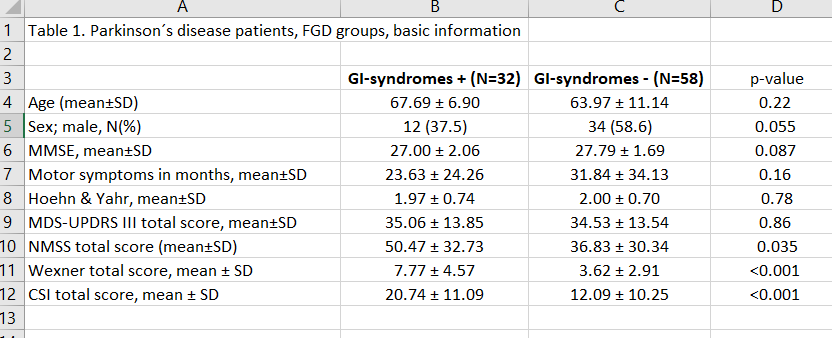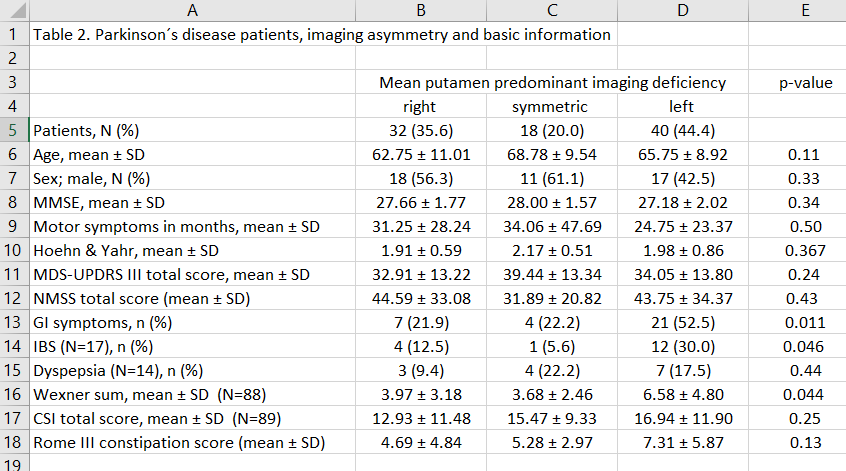Category: Parkinson's Disease: Non-Motor Symptoms
Objective: To assess correlations between functional gastrointestinal (GI) symptoms and nigrostriatal dopamine transporter imaging asymmetry in Parkinson´s disease (PD) patients. Based on a theory that PD might start from the gut, we would expect patients with symmetric transporter imaging deficit to have more GI symptoms.
Background: GI symptoms are common in Parkinson’s disease, but it remains unclear if these symptoms correlate with striatal dopamine function.
Method: 90 PD patients, who underwent dopamine transporter ¹²³I-FP-CIT SPECT imaging in the University Hospitals of Helsinki and Turku, Finland, were recruited between the years 2015-2019. The severity of PD symptoms was assessed with MDS Unified Parkinson´s Disease Rating Scale part III (MDS-UPDRS) at the time of imaging. GI symptoms were evaluated using questionnaires e.g. Rome III, Wexner and Constipation severity instrument.
We used Rome III criteria for the identification of functional GI disorders (FGD): irritable bowel syndrome, functional constipation, functional diarrhea, functional dyspepsia, postprandial distress syndrome and functional bloating. Specific dopamine transporter binding was calculated from striatal subregions (caudate, anterior putamen, posterior putamen) using region-to-occipital cortex ratio with BRASS software. We calculated the asymmetry index (AI) for predominant side of dopamine transporter imaging defect for mean and posterior putamen. Mann-Whitney U, T-test, Chi-Square, One-Way ANOVA, and Kruskal-Wallis test were used to assess if symptoms of FGDs correlated with the AI of the dopamine transporter imaging defect.
Results: The criteria for at least one FGD were fulfilled in 36% of PD patients. The majority of patients with FGDs were female (62.5%) (Table 1). 20% of PD patients had a symmetrical binding defect, whereas 36% had right, and 44% left predominant defect in mean putamen. FGDs were significantly more common in patients with left predominant defect than in those with symmetric or right predominant defect (52%, 22%, and 22%, p=0.011). Patients with left predominant defect also had higher Wexner scores compared to other groups (p=0.044), Table 2.
Conclusion: FGDs and symptoms of constipation were associated with reduced dopaminergic activity predominantly in the left putamen. Our results suggest a link between the laterality of dopaminergic neurodegeneration and gastrointestinal symptoms in PD.
To cite this abstract in AMA style:
K. Murtomäki, T. Mertsalmi, E. Jaakkola, E. Mäkinen, R. Levo, T. Nojonen, M. Eklund, S. Nuuttila, K. Lindholm, E. Pekkonen, J. Joutsa, T. Noponen, T. Ihalainen, V. Kaasinen, F. Scheperjans. GASTROINTESTINAL SYMPTOMS ARE ASSOCIATED WITH LEFT PREDOMINANT DOPAMINE TRANSPORTER BINDING DEFICIT IN PARKINSON´S DISEASE [abstract]. Mov Disord. 2021; 36 (suppl 1). https://www.mdsabstracts.org/abstract/gastrointestinal-symptoms-are-associated-with-left-predominant-dopamine-transporter-binding-deficit-in-parkinsons-disease/. Accessed July 18, 2025.« Back to MDS Virtual Congress 2021
MDS Abstracts - https://www.mdsabstracts.org/abstract/gastrointestinal-symptoms-are-associated-with-left-predominant-dopamine-transporter-binding-deficit-in-parkinsons-disease/


